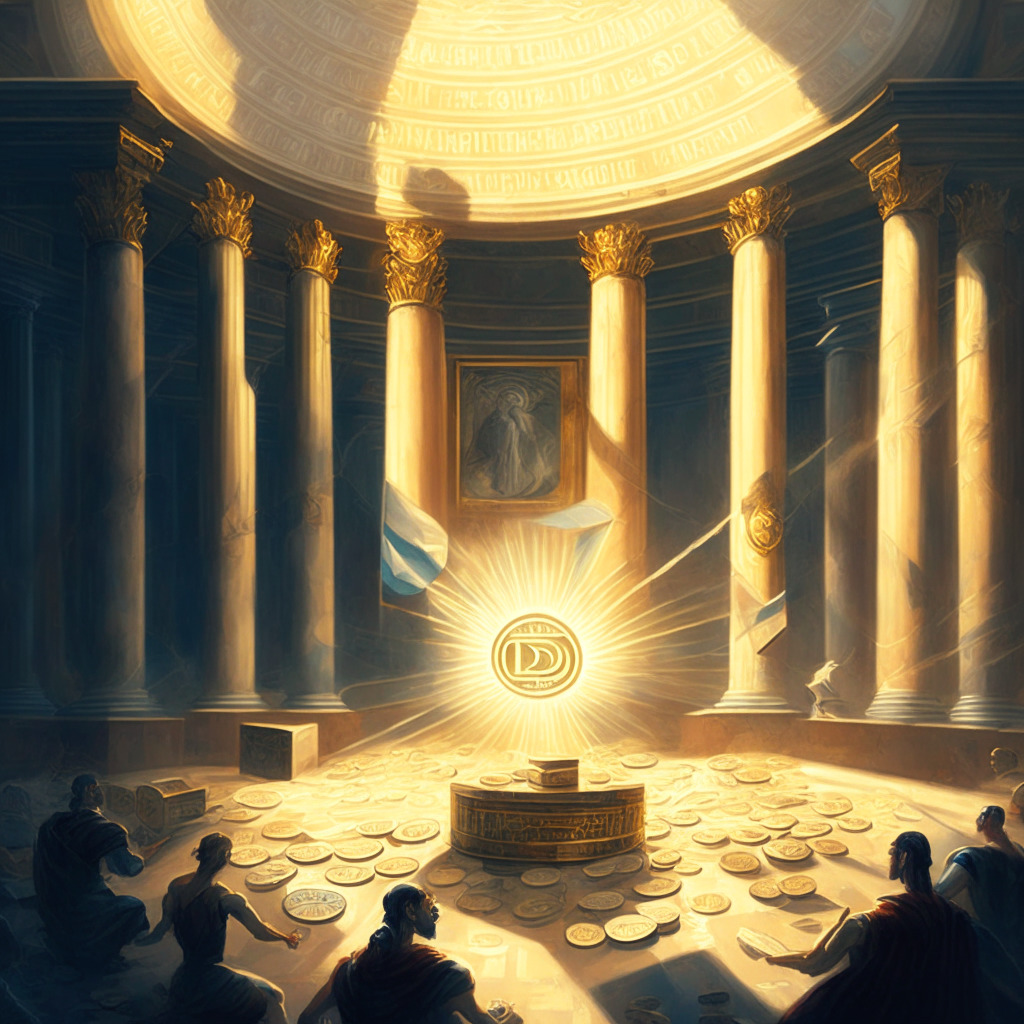“VISA has enhanced its stablecoin settlement ability with Circle’s USDC stablecoin on the high-speed Solana blockchain, making it one of the first financial institutions to harness Solana for scaled settlements. VISA’s integration of stablecoins like USDC on global blockchain networks aims to improve international settlements speed and give clients a modern option to conveniently transact funds.”
Search Results for: us treasury
Navigating Crypto Regulations: Binance Australia’s Unfolding Narrative Amid Trials and Triumphs
“Binance Australia faces regulatory challenges and halted transactions due to high scam risks. Despite this, they remain committed to working with local authorities and resuscitating services for their customers. The Australian Treasury seeks to establish a token classification framework by 2024, marking a significant step towards a regulated crypto market.”
Australia’s Crypto Future: Binance’s Battle for Acceptance Amid Regulatory Tensions
“Cautious optimism pervades the Australian crypto community as Binance Australia General Manager Ben Rose voices confidence that regulators will create suitable guidelines for digital assets, despite recent regulatory tensions and banking blocks. Restoration of banking relationships and resuming fiat ramp service are top priorities.”
MakerDAO’s Counter-Market Surge: A Profitable Anomaly or a Dangerous Catch?
Despite the downturn in cryptocurrency prices, Maker (MKR) saw a significant rise due to modifications made to its lending rates in its core strategy. This reflects in MakerDAO’s recent bounce back to profitability, contrasted by a crypto market drop. The platform also launched a token buyback plan, boosting investor profits. Nevertheless, caution in investing practices is advised due to the unpredictable nature of the crypto space.
Tether’s New Link with Bahamas-Based Britannia Bank: A Boon or Bane for the Crypto Industry?
Tether, the issuer of popular stablecoin USDT, has established banking relations with Britannia Bank & Trust. This connection could streamline dollar transfers, improving Tether’s functioning within the traditional financial network. Britannia’s recent acquisitions and positive stance on crypto suggest this relationship is strategic for both entities, impacting the future of the crypto industry.
Binance Quietly Removes Banco de Venezuela: Blockchain Freedom Versus Economic Sanctions
Cryptocurrency exchange Binance has silently removed Banco de Venezuela from its P2P service list, mirroring U.S Treasury-imposed financial sanctions. The move raises concerns among Venezuelan crypto enthusiasts, notably because the bank plays a crucial role in Venezuela’s digital currency ecosystem. Despite the silent removal, users can reportedly circumnavigate the ban due to the P2P nature of the services.
USTY Tokens: Revolutionizing the Financial Sector Despite Intense Rivalries and Market Volatility
“USTY tokens, a tokenized version of shares in a U.S. Treasury bond ETF, are the prime example of the tokenization of real-world assets. This transition towards tokenization could create a $5 trillion market within five years. Despite challenges, tokenization has potential to transform financial infrastructure, backed by nearly sixfold increase in demand for tokenized Treasuries to $622 million this year.”
Robinhood’s Mysterious $3 Billion Bitcoin Wallet: A Deep Dive into the Brewing Controversy
Robinhood is reported to control a single Bitcoin wallet with over $3 billion, ranking third behind Binance and Bitfinex in terms of Bitcoin holdings. Despite this, Robinhood experienced an 18% slump in crypto trading volume in Q2, creating questions regarding the ownership and acquisition of such vast wealth amidst declining trading volumes.
Removing Sanctioned Russian Banks from Crypto Exchanges: A Double-Edged Sword for Global Compliance
Crypto exchanges OKX and ByBit have excluded sanctioned Russian banks, including Tinkoff Bank and Sberbank, from their payment options. Despite their removal, private transactions through these banks continue. The development highlights the friction between user services and adhering to international financial regulations in the crypto industry.
Navigating the Storm: Treasury’s Proposed Crypto Tax Rules Stir Controversy and Promise
The U.S. Treasury Department’s proposed digital assets tax rules have sparked controversy within the crypto community. The debate revolves around the feasibility of regulating decentralized operations and potential implications for wallet vendors, decentralized exchanges, and smart contract systems. Nonetheless, a clear taxation path might facilitate easier engagement with digital assets.
Bitcoin’s Resilience amidst Monetary Shocks: A Debate on Investment Stability versus Volatility
Jerome Powell’s hawkish remarks prompted an initial dip, then rebound, for bitcoin, showcasing the cryptocurrency’s resilience to external monetary shocks. Despite volatile tendencies, cryptocurrencies may offer an alternative, potentially stable investment option, even amidst fluctuating traditional markets and restrictive monetary policies.
Crypto Custodianship Catastrophe: Examining the Financial Mismanagement of Prime Trust
“The case of crypto custodian Prime Trust losing $8 million in a terraUSD algorithmic stablecoin investment highlights the huge risks involved in such ventures. This comes alongside allegations of mismanagement and imprudent financial practices, and serves as a stern warning about the high-stakes and minimal margin for error in the crypto market.”
Weathering the Storm: How Exodus Survives and Thrives Amid Crypto Ebb and Flow
“Despite a bearish market, multichain wallet Exodus reported Q2 2023 revenue of $12.4 million, a modest 4% dip year-over-year. Notable was a strong fiat onboarding revenue increase, up 220% from 2022. High trade volumes came from Bitcoin, Tether and Ether. Strikingly, Exodus alleviated some financial stresses by drastically cutting administrative and marketing budgets by 65%, resulting in administrative expenses shrinking to 32.2% of revenue.”
Mantle’s Strategic Gamble: Staking ETH, Treasury Diversification, and Community Empowerment
“Mantle, a Layer 2 network, has staked 40,000 ether on staking protocol Lido, signifying a strategic shift. This stake, equivalent to approximately $66 million, is expected to generate 4.1% APR adding to Mantle’s $3.2 billion treasury. Following a governance vote, community members now have the power to strategize treasury management.”
Navigating Bitcoin’s Dance with US Inflation-Adjusted Bond Yield: Unraveling Market Movements
“Recent market analysis shows Bitcoin and the U.S. inflation-adjusted bond yield showing the strongest negative correlation in four months. This dynamic suggests that traditional finance and macro influences on Bitcoin’s price movement are audible once more. This trend showcases the influence of real yields on high risk alternatives such as technology stocks and cryptocurrencies.”
Blockchain regulation: A deep dive into the Tornado Cash vs Treasury case and its implications
“The case underscores a delicate dynamic in the blockchain world – the continuous tussle between freedom and control, between decentralized finance and government intervention, each with weighty implications on the other. This case symbolizes a battle of principles, signaling a profound shift in the future of blockchain technology.”
Clash of the Titans: Crypto Community vs U.S. Treasury in Tackling Anonymity and Regulation
“Regulation in the crypto world came under scrutiny after a lawsuit backed by Coinbase challenged the U.S. Treasury Department’s sanctions on Tornado Cash, a crypto transaction platform. Despite uproar from the crypto community, a judge ruled that the Treasury acted within its powers, escalating the ongoing tension between crypto advocates and regulatory bodies.”
Bankruptcy Brawl: FTX’s Contentious Reorganization and the Battle with Creditors
The ongoing legal dispute between bankrupt cryptocurrency firm FTX and its creditors intensifies. The firm, owing $8.1 billion in customer debt, is proposing a reorganization plan to resolve its issues, which has been met with backlash from the creditors’ panel. The panel, comprised mostly of crypto traders and market makers, is accused of reckless disposition and risk-taking. Amidst these power struggles, the negotiation process for a restructuring scheme may be prolonged.
PayPal’s Venture into Crypto: Exploring Revenue Opportunities and Regulatory Challenges with PYUSD
PayPal is launching its own stablecoin, the PYUSD, targeted to become a new revenue channel for the company. Yielding interest from US dollar deposits and transaction fees, the coin aims to venture into the realms of remittances and gaming. However, potential regulatory scrutiny could impact its trajectory.
Saddle Finance Shutdown: A Portentous Shift in Blockchain dynamics or a Necessary Precaution?
“The recent announcement of Saddle Finance, an Ethereum-based crypto trading protocol, to cease operations and disburse its treasury to its investors, paints an intriguing picture of the changes in the blockchain space. This incident, following a major hack on Curve, serves as a stark reminder of the ever-present threat of exploitable bugs in the blockchain universe, and stresses the importance of investor vigilance.”
Mantle’s $4.2 Billion Treasury: Why the New Economics Committee Can be Both a Blessing and a Curse
“Mantle community is establishing an economics committee to manage its $4.2 billion treasury, largely consisting of its governance token MNT and stablecoins USDC and USDT. The formation expresses a desire for accountability and democracy in decision making, but raises questions about the solidity of Mantle’s financial base due to crypto volatility.”
Tether’s Billion-Dollar Quarterly Profits: Financial Health or Cause for Concern?
“Tether’s self-reported asset value of over $86 billion surpasses the market cap of its USDT stablecoin. While the brand boasts a $1 billion profit, skepticism arose from its financial history and reduced cash holdings, opening conversations about the need for a full-fledged audit.”
Stablecoins: A Counterbalance Against De-dollarization and Boost for US Global Standing
“U.S. regulated fiat-backed stablecoins could counterbalance the weakening dominance of the dollar due to de-dollarization efforts by BRICS and emerging markets. Pegged to the U.S. dollar, these digital tokens merge traditional currency stability with cryptocurrencies’ technological strength.”
Closing the $50 billion Crypto Tax Gap: Urgent Measures or Rushed Consequences?
Democratic Senators, including Elizabeth Warren and Bernie Sanders, urged the IRS and the Treasury Department to expedite new crypto tax regulations to close a potential “$50 billion crypto tax gap.” They expressed concerns about potential loss of $1.5 billion in government tax revenue for 2024 due to delay in the implementation. This is amid a wider conversation for more transparency in the bourgeoning cryptocurrency sector.
Bitcoin vs Traditional Assets: Insight from Downgraded US Debt and Crypto’s Market Stand
“Unlike the 2011 market panic, the crypto market now seems fairly calm following the US Government debt downgrade. Bitcoin’s maturity as an asset class has resulted in better correlation to global events. The digital asset market continues to offer potential amidst transformative moments, despite uncertainties like the Ripple vs SEC conflict.”
Fitch Downgrades US Credit Rating: An Opportunity or Threat for Cryptocurrencies?
Fitch has downgraded the US government’s credit rating from AAA to AA+, sparking concerns of potential impact on the cryptocurrency market. Crypto enthusiasts suggest this demonstrates weakening traditional economic structures, advocating a transition to decentralized financial systems utilizing cryptocurrencies like Bitcoin and blockchain technology.
US Defense Bill’s Impact on Stablecoins: A Compliance Conundrum in the Offing
The U.S. national defense bill could pose compliance challenges for stablecoins like USDC due to proposed Know Your Customer (KYC) and anti-money laundering (AML) measures. The standards may affect stablecoin holders’ identities and impact USDC’s market cap. The bill’s implications could also affect Coinbase, which derived almost 27% of its net revenue from USDC in Q1 2021.
Tether’s Rising Treasury Reserves: A Balancing Act between Expansion and Security
“Tether recently disclosed a Q2 attestation, revealing a $3.3 billion jump in its excess reserves. Despite raising market concerns due to increasing U.S. Treasury bill holdings, Tether maintains 100% reserves for USDT tokens and continues growing financially. Transparency around reinvested profits becomes key to investor confidence.”
The Unraveling of Hector Network: Decentralization Predicament and the Illusion of Quick Exits
The formerly $100 million treasury of stablecoin project, Hector Network, has collapsed to $16m following the Multichain bridge’s demise. The DAO’s liquidation process is causing community frustration given its complexity and projected 6 to 12-month timeframe. Hector’s endeavors beyond stablecoin, including a token launchpad and NFT marketplace, might have diluted its focus and deepened the treasury situation.
US Crypto Regulation: A Patchy Landscape and the Urgent Need for Unified Oversight
“A recent report by the United States Government Accountability Office (GAO) shows significant regulatory gaps in the crypto assets market. It highlights the need for unified coordination to counter blockchain risks and establish a timely response system. Particularly, the report emphasizes rising concerns around stablecoins and decentralized finance’s escalating risks to the crypto and macro economy.”
Emerging Trends: How ISIS Uses Cryptocurrency and Blockchain Technology for Funding Activities
“Affiliate groups of ISIS are increasingly utilizing cryptocurrency, specifically Tether stablecoins on the Tron network, suggests a report by TRM Labs. Regions such as Tajikistan, Indonesia, Pakistan, and Afghanistan are particularly active. This misuse of digital currencies underscores the importance of tracing blockchain donations and identifying donors to thwart pro-ISIS networks.”
The Struggle of Terraform Labs Amid Accusations, Market Woes and Strict Regulations
Interim CEO of Terraform Labs, Chris Amani, expressed his frustration over litigation issues stunting the company’s growth. Despite ongoing legal challenges and market volatility, the company aims to innovate and evolve within the crypto sector with focus shifted to utility of their native token, Luna.































